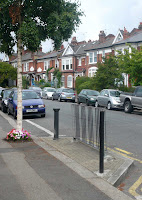It is hardly worth writing about the journey from Wood Green to Muswell Hill. It is only a couple of miles and in my mind they are both part of the same area. We had a small flat on the higher priced hill then moved down to somewhere nearby where we could afford a larger flat. That was all.
So here I am in Dukes Avenue, late morning on a weekday and everything is exceptionally quiet. There is nobody in sight and no movement apart from an occasional car. It is amazing how peaceful residential streets can be in the daytime. There are picturesque villages near me, full of people who have escaped ,the rat race of London that are busier during the day. It is just one of those minor paradoxes that you can find patches of quietness amongst the bustle.
In the same way cities and towns can be better places for running than rural areas. There are parks and quiet roads, and often specific facilities designed for active leisure, whilst in the country open fields are enclosed for agriculture, the footpaths are not necessarily suitable for running and roads don't have pavements. Sometimes the visual appeal of fields and landscape, whilst important and stimulating, is not necessarily everything.
So here I am thinking like a city boy and looking at another paradox: it is easy to think of cities as places of constant change but here the only thing that has obviously changed is the barriers. Just as at Wood Green, I could walk down this road and feel like I had only been away to buy a newspaper.
Because it is the obvious change I focus on the barriers. As a generality I don't like pedestrian barriers (I often think they come from the same people who specify useless cycle paths). They herd people, make the pavement constricted, are visually ugly, and close things off. I don't know how much they protect pedestrians from traffic and if that could be proved then I would have to eat my prejudices. This little barrier is a case in point at first sight it looks totally footling but I have a smidgen of doubt: do the flowers at the base of the tree mark an accident?
That not a lot has changed is one of the charms of Muswell Hill. One of the first things I did when arriving was to check how many of the local shops still survived. Many do. First I went to the bookshop, as I know the independents are really struggling, and I was heartened to see it still there, with the separate shop for children's books (something I really like). I worry though, as the fixtures and fittings look worn and this is probably a sign that there is not much money to spare for investment Next was the cheese shop – yep still there, smelling strong. You can tell quite a lot about the character of a place from its shops and a specialist cheese shop could survive in very few areas.
However the key shop to check was http://www.wmartyn.co.uk/">Martyn's. If my journey has been about continuity and change than what finer example of continuity than something that has been here for 123 years. Wonderfully it still roasts its own coffee. This is one of my favourite smells, also evokes childhood memories. When I was a little boy, visiting my grandmother in Croydon, a treat was to go to a wonderfully old fashioned cafe, Wilson's, for a doughnut (a lovely proper doughnut: round, sliced at the top, and with the gash overflowing with jam). Wilson's also roasted their own coffee. The roaster in the window and I can remember being fascinated by watching the drum rotate and its brown patina.
This is the last stop of the South Riding and this small detail links it to the first. A tiny circle is completed












